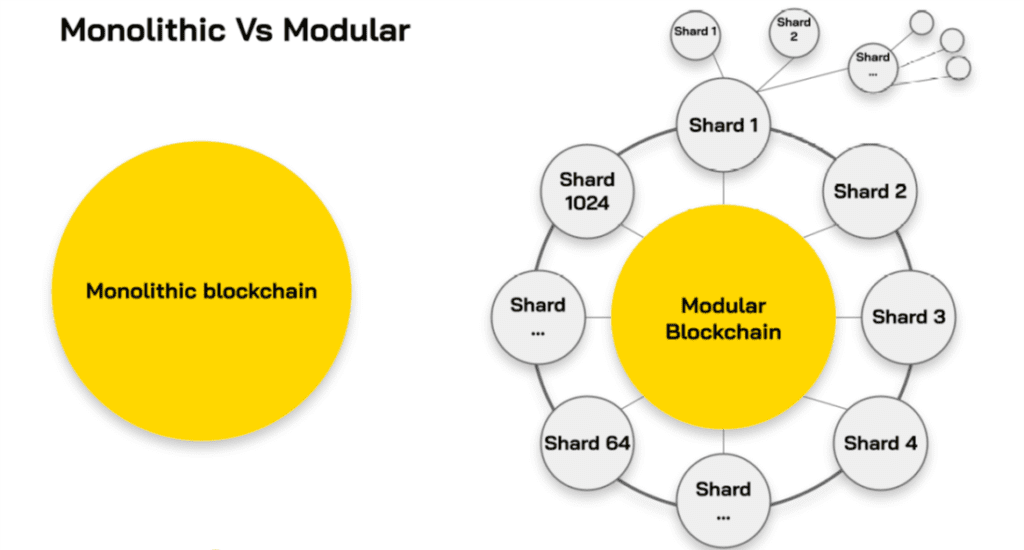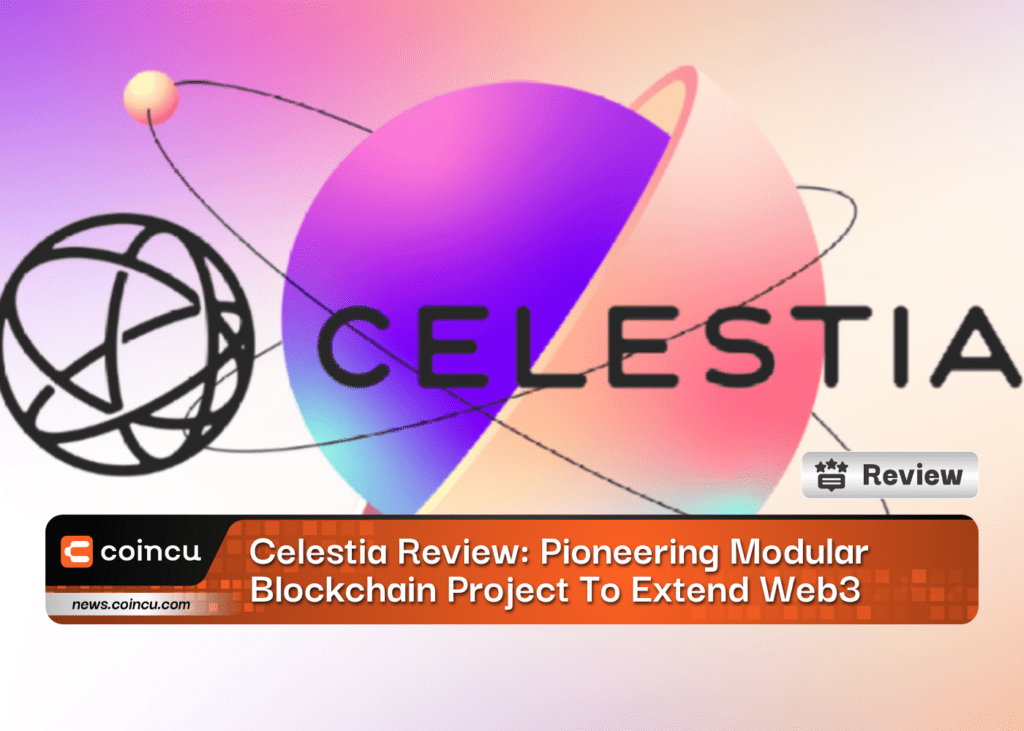In recent times, the phrase “Modular Blockchain” has emerged in the crypto community as a technological innovation for the development of the DeFi market. Modular Blockchain is expected to be one of the next developments, helping to overcome the limitations of the “old” Blockchain. In this Celestia review, let’s find out through the article below.
Why Modular Blockchain?
Modular Blockchain is a blockchain that shares the above tasks for many interconnected networks, helping to optimize performance and increase scalability many times.
Before that, almost all the blockchains we know are monolithic blockchains, such as Solana, Near, Binance Smart Chain, etc. Even Ethereum, at the present time, is also a monolithic blockchain, but Ethereum has a plan to become a modular blockchain in the future. Monolithic Blockchain is a Blockchain that handles all of the above tasks, work on a single layer.

There is no denying what the Monolithic blockchains have brought to Crypto, but they are slowly reaching their limits. The most typical is the problem of Ethereum’s scalability, high cost, and slow speed that create barriers between a large number of users.
We will need a newer, more efficient version of the Blockchain that addresses the limitations of the Monolithic Blockchain, and the Modular Blockchain is the answer.
Sharing tasks for multiple interconnected networks is similar to the production line example above, helping to optimize the resources of each department and help create a more efficient product, not to mention the fantastic scalability they can offer.
What is Celestia?
Celestia is the first Modular Blockchain that allows other Blockchains to link to use the consensus mechanism as well as the data available, thereby increasing the speed and improving the performance of the attached blockchains.
At the present time, Monolithic Blockchains such as Near, Solana, etc. have to perform many functions at the same time, such as calculating and processing transactions, implementing consensus mechanisms, and storing data. This leads to a problem in the future as Blockchain grows with increasing transaction volume causing network congestion. This problem is familiar and Ethereum itself has been developing Layer 2 to help free Layer 1 from the task of computation and transaction processing.
With a similar vision to Ethereum, Celestia will also have a two-layer model: Consensus & Data Layer and Execution Layer. However, the Execution Layer at Celestia is not just rollups of offchain transaction processing, but can also be different independent blockchains and connect to Celestia via cross-chain bridge.
How does Celestia work?
Celestia adopts a modular architecture, which separates the blockchain stack into specialized components. The core functions, consensus, and execution, are separated into different layers.
A monolithic architecture can be limited. The execution and consensus functions are encapsulated in a class, and then the smart contract will be built on this encapsulated layer. Users are constrained to an execution environment, limiting the ability to optimize and specialize for specific use cases.
A modular architecture separates consensus and implementation into separate layers. The execution layer lives on its own Blockchain, allowing optimization and specialization for specific use cases. Any developer building decentralized applications built on this architecture will get better flexibility, security, and scalability.
In a modular blockchain, data availability sampling can be achieved, allowing a node to verify a block with a small sample, such as verifying a 100 MB block with only 10 KB of data. A machine with minimal processing power, like a smartphone, can act as a button.
When developers build dApps on Celestia directly, they can choose which execution environment to use and run as many execution environments in parallel as they like. In a monolithic environment, consensus tightly ties the rules of execution, meaning that users are bound to whatever execution environment the base chain supports.
In the future, we may see the Tendermint chain and the Cosmos region using Celestia as the available data layer. These zones will minimize trust by using proofs of fraud to provide the Cosmos ecosystem with a uniform level of security and help reduce reliance on social governance when dealing with harmful zones.
Celestia Review: Highlights
Separation of consensus layer and implementation layer:
Celestia provides a consensus layer with an open pending mechanism so that developers of the implementation can plug in and run quickly. Along with that, the separation of the two layers helps the developer of the implementation layer to customize the Blockchain to specialize the output function, for example, for NFT, Game is for speed, and Defi is for security.
Data proof available:
Celestia encrypts block data with a 2-way reed-solomon so that all data can be tested against a small sample of randomly selected data instead of having to check the entire data. If the data is encrypted incorrectly, the network will be notified via fraudulent evidence of its availability. This makes it possible for Celestia to store more data and reduce validation times.
Off-chain transaction processing (Rollups):
With the above data storage structure, Celestia shows the potential to be the perfect environment to develop Rollups (off-chain transaction execution) when: Optimistic rollup needs data to prove the invalidity of the rollup transaction error and zk-rollup needs complete data to re-aggregate the state of the chain.
Protecting light clients in cross-chain interactions:
Celestia’s cross-chain interoperability implementation will not assume that the light clients give real public information but that the interaction will only be opened once the secure transaction is correctly verified.
Celestia Review: products
- Ring Signatures: are electronic signatures that allow the sender to conceal their identity from others in a group. To create a ring signature, Celestia combines a sender’s key and the public keys on the Blockchain. It hides the identity of the sender, since it is computationally impossible to determine which key was generated and by whom.
- Stealth Addresses: creates a layer of anonymity between your public address and the Celestia you own. Addresses on the publicly available Celestia blockchain are hidden addresses, so personally identifiable information is completely off the Blockchain.
- Ring Confidential Transactions: Ring CT technology allows the amount sent for a transaction to be hidden while maintaining the network’s ability to verify transaction value. As a result, transactions no longer need to be split into different denominations and wallets are free to choose ring members from any output and regardless of amount, which provides a significant improvement in terms of privacy for Celestia.
Celestia Review: Tokenomic
Celestia is intended to have a token that can be used to secure the network through a Proof of Stake mechanism and to pay transaction fees on the network and eventually a fee burning mechanism similar to EIP-1559 in Ethereum. However, not much information has been revealed yet.
Celestia Review: Team
Mustafa Al-Bassam, CEO of Celestia Labs, holds a Ph. in blockchain scale at UCL. He previously co-founded Chainspace, a forked smart contract platform that Facebook later acquired. Mustafa has also written a number of topical papers on the security of fragmented blockchain systems.
John Adler, CRO, Celestia Labs, is a Layer 2 scalability researcher. He previously worked at ConsenSys, working on Phase 2 of Ethereum 2.0. Inspired by Mustafa’s work on data availability, Adler created the first specification for an optimistic totals scheme.
Ismail Khoffi, CTO of Celestia Labs, is a reputable research engineer with many years of experience. In addition to building academic research prototypes, he has also contributed to bringing various Blockchain and non-blockchain projects such as Google UK and Tendermint to production.
Nick White, COO of Celestia Labs, holds a BS & MS degree from Stanford. Prior to joining Celestia, Nick White co-founded Harmony, a blockchain protocol that builds scalable blockchain infrastructure to drive the decentralized revolution. White worked there from June 2018 to December 2020. He is also a senior AI specialist at Zeroth.ai, an accelerator program for AI startups in Asia.
Celestia Review: Roadmap
Celestia is in the process of implementing Incentivized Testnet – this is usually a campaign to encourage people to experience the testnet and receive airdrops (such as Aptos once held 3 Incentivized testnets and “huge” airdrops for participants).
Conclusion
Scalability is one of the biggest barriers to the full adoption of blockchain technology. While a few Layer 1 scaling solutions exist, most are focused on block production, not block verification. With scalability, security and decentralized features, the first Modular Blockchain Network, Celestia, is preparing us for Web 3. Celestia is not the only solution as Polygon has Avail and Ethereum there’s Danksharding. However, Celestia is unique because it focuses on ease of integration, fast delivery, and user experience.
Celestia is currently mostly still in the product development stage. With the testnet implementation, the project is gradually approaching the time of official operation. Currently, this Blockchain has not conducted any more funding rounds. Still, I predict that when the testnet is completed and the mainnet is launched, the project will continue to raise more capital in the next rounds.
During this time, you can participate in testnet node programs to receive retroactive. Although not officially put into operation, Celestia is also one of the leading projects in a completely new niche. Therefore, we have the right to wait and expect its explosion like the Solanas, Avalanche…
Join us to keep track of news: https://linktr.ee/coincu
DISCLAIMER: The information on this website is provided as general market commentary and does not constitute investment advice. We encourage you to do your own research before investing.





